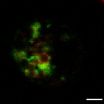Study reveals how a Rab protein controls HIV-1 replication
2015-05-04
(Press-News.org) HIV-1 replication requires the coordinated movement of the virus's components toward the plasma membrane of an immune cell, where the virions are assembled and ultimately released. A study in The Journal of Cell Biology reveals how a Rab protein that controls intracellular trafficking supports HIV-1 assembly by promoting high levels of an important membrane lipid.
New HIV-1 particles assemble at specialized sites in the plasma membrane that are enriched in PIP2, a phospholipid component of the membrane that recruits a viral protein called Pr55Gag (Gag) that directs HIV-1 assembly. Because certain cell secretion pathways have been suggested to be required for this process, University of Buenos Aires researcher Matías Ostrowski and colleagues investigated whether a role might be played by Rab27a, a protein that guides delivery of membrane-bound compartments called endosomes to the plasma membrane.
Ostrowski and colleagues found that viral replication was impaired in immune cells lacking Rab27a. These cells showed reduced levels of PIP2 at the plasma membrane and thus failed to recruit Gag to form viral assembly sites. The researchers determined that Rab27a boosted PIP2 production at the plasma membrane by controlling the endosomal delivery of an enzyme that is necessary for production of the phospholipid to the cell periphery.
Ostrowski believes that these results open a path to investigate whether manipulating endosomal traffic could be a new target for anti-HIV-1 therapies.
INFORMATION:
Pereyra Gerber, P., et al. 2015. J. Cell Biol. doi:10.1083/jcb.201409082
About The Journal of Cell Biology
The Journal of Cell Biology (JCB) is published by The Rockefeller University Press. All editorial decisions on manuscripts submitted are made by active scientists in conjunction with our in-house scientific editors. JCB content is posted to PubMed Central, where it is available to the public for free six months after publication. Authors retain copyright of their published works, and third parties may reuse the content for non-commercial purposes under a creative commons license. For more information, please visit http://www.jcb.org.
[Attachments] See images for this press release:


ELSE PRESS RELEASES FROM THIS DATE:
2015-05-04
What do you think is the biggest cause of death for firefighters on duty? Well if your first thought was burns or smoke inhalation you'd be wrong! According to research published in the June edition of Vascular Medicine "since 1977, sudden cardiac death has accounted for the largest share of on-duty deaths among firefighters - surpassing burns, trauma, asphyxiation and smoke inhalation."
Although the number of deaths amongst firefighters is declining, cardiac death still counts for 42% of deaths in on-duty firefighters over the past 5 years. This is an astonishingly ...
2015-05-04
Even non-professionals may someday be able to create high-quality video panoramas using multiple cameras with the help of an algorithm developed by a team of Disney researchers.
Their method smooths out the blurring, ghosting and other distortions that routinely occur when video feeds from unstructured camera arrays are combined to create a single panoramic video. The algorithm corrects for the apparent difference in position of an object caused by different camera angles - known as parallax - and image warping that occurs because of slight timing differences between ...
2015-05-04
Madrid, Spain - 4 May 2015: Patients with rheumatoid arthritis are at increased risk of a surprise heart attack, according to new research presented today at ICNC 12 by Dr Adriana Puente, a cardiologist in the National Medical Centre "20 de Noviembre" ISSSTE in Mexico City, Mexico. Risk was increased even when patients had no symptoms and was independent of traditional cardiovascular risk factors such as smoking and diabetes.
Dr Puente said: "Our study suggests that one quarter of patients with rheumatoid arthritis and no symptoms of heart disease could have a heart attack ...
2015-05-04
New research from the Canadian Healthy Infant Longitudinal Development (CHILD) study shows that exposure to outdoor air pollution during the first year of life increases the risk of developing allergies to food, mould, pets and pests.
The study, published in the journal Environmental Health Perspectives, showed that the sensitivity to allergens was associated with exposure to traffic-related air pollution during infancy.
"With the increasing rates of allergies amongst children in Canada and elsewhere, we were interested in determining if air pollution from traffic might ...
2015-05-04
Two ocean hot spots have been found to be the potential drivers of the hottest summers on record for the Central US in 1934 and 1936. The research may also help modern forecasters predict particularly hot summers over the central United States many months out.
The unusually hot summers of 1934/36 broke heat records that still stand today. They were part of the devastating dust bowl decade in the US when massive dust storms travelled as far as New York, Boston and Atlanta and silt covered the decks of ships 450km off the east coast.
Research by Dr Markus Donat from the ...
2015-05-04
Doping is damaging the image of sport without benefitting athletes' results, according to University of Adelaide research.
Researchers from the University's School of Medical Sciences collated sporting records (including Olympic and world records) of male and female athletes across 26 sports, between 1886 and 2012. Comparisons were made between pre-1932 records (when steroids became available) and post, and it was found that the times, distances and other results did not improve as expected in the doping era.
The findings were published in the Journal of Human Sport ...
2015-05-04
Australian scientists have shown that a specific gene determines the development and function of important cells that bridge the gap between our fast-acting 'innate', and slower-acting 'adaptive', immune systems.
STAT3, as it's known, helps shield us against a variety of fungal and bacterial infections, and understanding its role may help in finding ways to boost our defenses.
Most of us barely give our immune system a thought, unless we are struck down by disease, or are born with an immunodeficiency that leaves us susceptible to constant attack.
'Primary immunodeficiencies', ...
2015-05-04
DNA (deoxyribonucleic acid) is the main component of our genetic material. It is formed by combining four parts: A, C, G and T (adenine, cytosine, guanine and thymine), called bases of DNA combine in thousands of possible sequences to provide the genetic variability that enables the wealth of aspects and functions of living beings.
Two more bases: the Methyl- cytosine and Methyl-adenine
In the early 80s, to these four "classic" bases of DNA was added a fifth: the methyl-cytosine (mC) derived from cytosine. And it was in the late 90's when mC was recognized as the main ...
2015-05-04
Offshore the Svalbard archipelago, methane gas is seeping out of the seabed at the depths of several hundred meters. These cold seeps are a home to communities of microorganisms that survive in a chemosynthetic environment - where the fuel for life is not the sun, but the carbon rich greenhouse gas.
There is a large, and relatively poorly understood, community of methane-consuming bacteria in this environment. They gorge on the gas, control its concentration in the ocean, and stop it from reaching the ocean surface and released into the atmosphere.
In the atmosphere ...
2015-05-04
A new study shows how pharmacies might collaborate with physicians and families to reduce asthma-related illness.
The Cincinnati Children's Hospital Medical Center study found that pharmacies in neighborhoods with high rates of asthma-related emergency-room use and hospitalization filled fewer asthma controller medications compared to asthma rescue medications.
Asthma-related illness is particularly common among people living in poverty or with limited access to medical care. Previous studies have shown that disparities in asthma rates are perpetuated by underuse of ...
LAST 30 PRESS RELEASES:
[Press-News.org] Study reveals how a Rab protein controls HIV-1 replication



